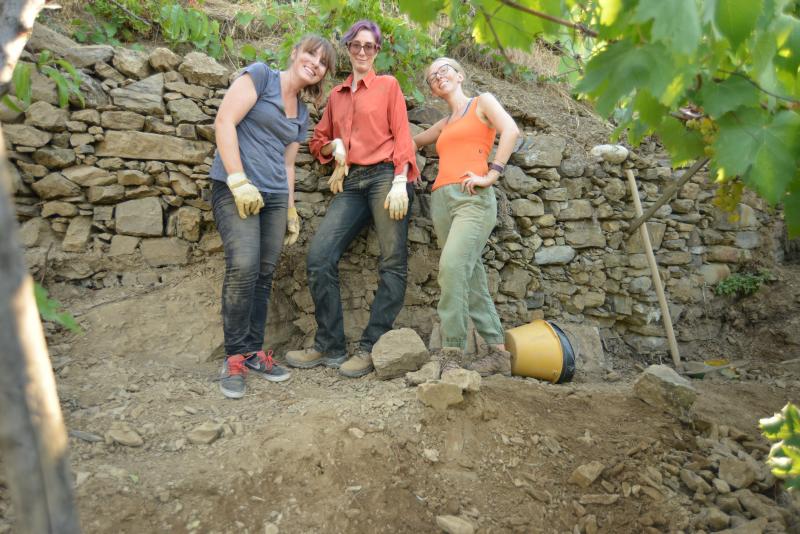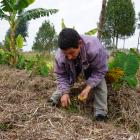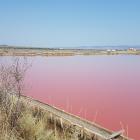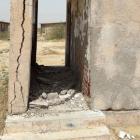Building Cinque Terre: A Grapevine Viewpoint (Italy)
Sarah Elizabeth Yoho
Yoho, Sarah Elizabeth. Building Cinque Terre: A Grapevine Viewpoint. 2018. HD, 3 min. https://youtu.be/IoY2AjzEix0. Video editing by Miriam Remter and Felix Remter (Primate Visions, Munich). CC BY 4.0.
This 360° video captures the process of constructing a dry stone wall in Italy’s Cinque Terre. In cooperation with community organization Tu Quoque Vernazza, it was filmed over nine days and is shown in time-lapse. We placed the camera in grapevines in order to give the grapevine’s point of view of Cinque Terre life. The front camera captured the wall, while the back camera captured the village of Vernazza and the sea. If you look up, down or to the sides, you will see grapevines. With this view, we wanted to show both the incredible beauty of Cinque Terre and the amount of work it takes to maintain the region’s dry stone walls.

Preparing to lift a large rock to the top of a wall. Pictured (left to right): Margherita Ermirio; Sarah Elizabeth Yoho. Photograph by Sarah Rose Liebau. CC BY 4.0.
Preparing to lift a large rock to the top of a wall. Pictured (left to right): Margherita Ermirio; Sarah Elizabeth Yoho. Photograph by Sarah Rose Liebau. CC BY 4.0.
Photograph by Sarah Rose Liebau
 This work is licensed under a Creative Commons Attribution 4.0 International License.
This work is licensed under a Creative Commons Attribution 4.0 International License.
Cinque Terre is one of the top tourist destinations in Italy. It is known for its moving terraced landscape, picturesque villages, vineyards overlooking the sea, and walking trails that crisscross the region. Its fragile environment, however, is inundated with issues of overuse: overcrowding, environmental degradation, struggles to maintain adequate public services, etc. The dry stone walls are the foundation of Cinque Terre’s terraced landscape. When walls work, it is easy not to notice them. When walls fail, it can be disastrous, leading to erosion, landslides, and loss of plants, animals, and human livelihoods.
To put it another way, without dry stone walls we would no longer have Cinque Terre. In a terraced landscape, wall failure is often attributed to neglect, erosion, or abandonment. Mass wall abandonment started during industrialization and accelerated following World War II. Erosion has worsened as tourism has increased, and weather, particularly extreme weather events like heavy storms or extreme heat, contribute to erosion. To combat wall failure, there are many diligent people and organizations dedicated to working to reverse wall destruction. Furthermore, UNESCO recently added dry stone walls in Italy and much of the Mediterranean to its List of Intangible Cultural Heritage of Humanity, which will hopefully raise international awareness about these walls. For more information on Cinque Terre wall building, visit Tu Quoque’s facebook page.

Building rock walls with Vernazza Cinque Terre in the background. Pictured (left to right): Margherita Ermirio, Sarah Elizabeth Yoho. Photograph by Sarah Rose Liebau. CC BY 4.0.
Building rock walls with Vernazza Cinque Terre in the background. Pictured (left to right): Margherita Ermirio, Sarah Elizabeth Yoho. Photograph by Sarah Rose Liebau. CC BY 4.0.
Photograph by Sarah Rose Liebau.
 This work is licensed under a Creative Commons Attribution 4.0 International License.
This work is licensed under a Creative Commons Attribution 4.0 International License.

Group photo after building a dry stone rock wall in Cinque Terre. Pictured (left to right): Sarah Rose Liebau, Margherita Ermirio, Sarah Elizabeth Yoho. Photograph by Sarah Rose Liebau. CC BY 4.0.
Group photo after building a dry stone rock wall in Cinque Terre. Pictured (left to right): Sarah Rose Liebau, Margherita Ermirio, Sarah Elizabeth Yoho. Photograph by Sarah Rose Liebau. CC BY 4.0.
Photograph by Sarah Rose Liebau.
 This work is licensed under a Creative Commons Attribution 4.0 International License.
This work is licensed under a Creative Commons Attribution 4.0 International License.
About the author
Sarah Elizabeth Yoho is an environmental anthropology PhD candidate at the University of Leeds who works within the environmental humanities research space. Her particular research focus is on modes of human and environmental resilience in Italian coastal communities. As part of her work, she has logged countless hours learning about the art of dry stone walling through involvement in community rock wall building projects.
- Previous chapter
- Next chapter












